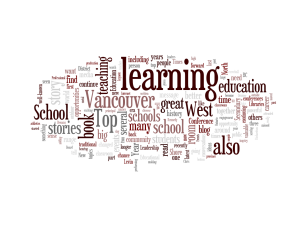Personalized learning has become one of those terms that can often elicit eye-rolls in a crowd of educators – so used and overused that it has been a word used synonymously with almost all current educational reforms. As I have joked, there are very few pushing for de-personalized learning. I have written a number of times on the topic, including specifically here in the fall of 2010, when I tried to wrestle with a definition.
This past week as part of a feature in the North Shore Outlook I was extensively quoted on what I see with personalized learning and just what it means. Here is the text:
Not all kids learn the same way. Traditional education hasn’t always had space to address these differences, but now the West Vancouver School District is looking to change that. It’s using personalized learning to shift the emphasis from traditional learning to an inquiry-based system that focuses on learning how to learn.
Chris Kennedy, Superintendent of Schools for the district, has been at the forefront of the push towards personalized learning for the last five years.Things are changing so quickly that the key facts to know right now just won’t be the same in five years,” says Kennedy. “The topics will be different. The content will be stale.” Rather than teach facts that will likely be obsolete in short order, the district is focusing instead on teaching students how to learn, rather than what to learn, in order to encourage them to continue learning far beyond their time at school. “Knowledge has become so easily accessible it changes the dynamic between teachers and students,” says Kennedy.
“In a more traditional classroom, students might take notes or answer questions at the end of the chapter. In an inquiry-based classroom… They start with an overarching theme, question or challenge and go from there – this encourages ownership, exploration and curiosity.” Kennedy adds that this approach often results in powerful demonstrations of learning in the form of projects, productions and exhibitions that show real sophistication.
Part of personalized learning includes different types of learning environments and opportunities for students. Technology is a big part of that. All schools in the district have wi-fi and teachers are provided with mobile devices to use in one-to one learning environments. Students are encouraged to bring their own devices, however, the district also provides devices for children who can’t afford their own or have forgotten theirs at home. But there are also other changes in classroom design, such as offering different work station options or the ability to opt-into an outdoor class rather than an indoor one.
“Personalized learning is about giving students more control – more choice – over what they’re learning, how they’re learning it, even when they’re learning… so students feel it’s more theirs,” says Kennedy. “It’s also important for students to know what they’re working on, how they are doing, and what they need to do
next to improve.” “It changes the students to being more the owner of the learning experience. The teacher spends more time guiding, rather than directing, learning.”Parents also have a key role to play in the district’s approach to learning. Educators hope that parents will have conversations with their children to discover what types of learning approaches work best for them so that teachers can address each child’s specific learning needs.
The district is already seeing success with the new model. “We have a long history of very successful students,” says Kennedy. “We’re finding that some students that might not have been as engaged are finding this approach more appealing. In some classrooms students are coming up with their own questions.”
Still a work in progress, but it is important to continue to talk about the future we are trying to create and put depth behind the terms we are using so often.










